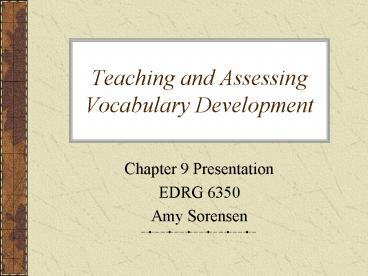Teaching and Assessing Vocabulary Development - PowerPoint PPT Presentation
1 / 8
Title:
Teaching and Assessing Vocabulary Development
Description:
Most children acquire a vocabulary of over 10,000 words during the first five ... Tally the number of miscalled words and list problematic words. ... – PowerPoint PPT presentation
Number of Views:346
Avg rating:5.0/5.0
Title: Teaching and Assessing Vocabulary Development
1
Teaching and Assessing Vocabulary Development
- Chapter 9 Presentation
- EDRG 6350
- Amy Sorensen
2
Vocabulary Development
- Most children acquire a vocabulary of over 10,000
words during the first five years of their life. - Most school children learn between 2,000 and
3,600 words each year.
3
Types of Vocabularies
- The largest type is the listening vocabulary.
These are words you hear and understand, but you
may not use them in your speech. - The next largest type is the speaking vocabulary
It consists of words you can hear, understand,
and use in speech. - The next largest type is the reading vocabulary.
It consists of words you can read and understand. - The smallest vocabulary is the writing
vocabulary. These are words you can understand
when listening, speaking, and reading, and you
can use them in your writing.
4
Reading Vocabulary
- Students must first acquire words as part of
their listening and speaking vocabulary in order
for them to read and understand the word. - Effective readers can maintain satisfactory
comprehension when up to 15 of the words in a
passage are unknown. - Readers having weak vocabularies tend to be
word-by-word readers and are much less able to
tolerate unknown vocabulary. - Many words require between five and twenty-six
minutes to be learned. - All vocabulary words must be known in such depth
that they can be recognized and used in a variety
of contexts and related to a range of
experiences. - The direct instruction methods in this chapter
can be effective in helping students learn
unknown words.
5
Oral Reading Assessment - Assessment
Demonstration, Page 229
- Purpose Problem vocabulary words in print can
be distinguished by the teacher quickly. - Materials Two copies each of three or four
reading passages used in your class at students
instructional or frustration level. Have a range
of passages to account for all students. - Procedure Give the student one copy and keep
one for yourself. Student reads aloud while you
note words that student doesnt know or
mispronounces. Repeat with all of the passages.
Tally the number of miscalled words and list
problematic words. Repeat with all students and
create a master list of problematic words.
Determine percent of students who had trouble
with each word and use the more frequent problem
words as part of your instruction.
6
Cubing The Die is Cast! Page 237 Instructional
Activity Demonstration
- Purpose This is a postreading activity
requiring student to analyze, discuss, and write
about new terms. - Materials Foam or wooden cube covered in
contact paper. Write a direction or question on
each side. - Procedure Students roll the cube. Teacher gives
a set number of minutes for students to record
answer. Students share responses when cubing has
ended.
7
Vocabulary Cluster, Page 247 Instructional
Activity Demonstration
- Purpose Students are directed to read a passage,
use context clues, and predict meaning of words
targeted by the teacher. - Materials Multiple copies of text and document
cameras. - Procedure Select words from the text. Place an
excerpt of the text on the document camera. Make
sure it has sufficient context to help students
know meaning of the word. Delete the target word
and replace it with a blank line. Come up with
words together to put in the vocabulary cluster.
Use these words to introduce the new word in the
center of the cluster.
8
Contextual Redefinition, Page 249 Instructional
Activity Demonstration
- Purpose A method of introducing vocabulary in
context and promoting use of context clues in
informational text. - Materials Chalkboard, projector, or activity
sheets. - Procedure
- 1 Choose 5 or 6 unfamiliar words. Introduce the
topic and words. Students or pairs predict the
meaning. Record predictions. Discuss why
students could only predict. - 2 Share the words written in a contextually
rich sentence or paragraph. Have them read each
passage and revise prediction. Students explain
why they think each word means what it means.
Record terms and explanations for each word. - 3 If there are differences, students will find
the word in the text or glossary and read the
definition. Students copy the word in their
notebooks.































